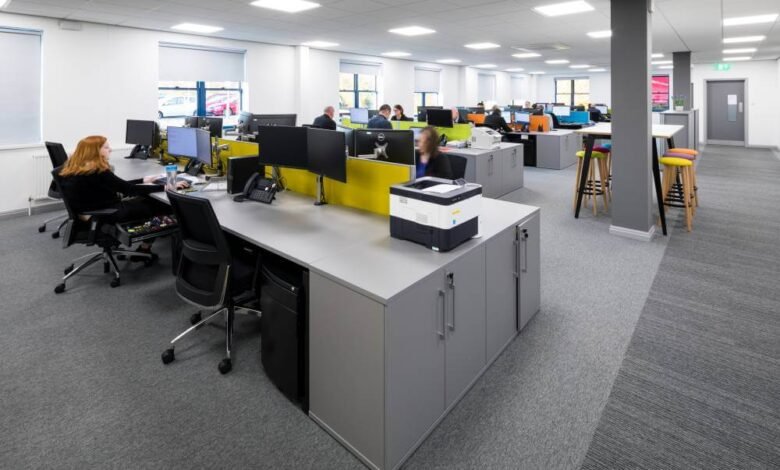The Science of Office Workstations: How Layouts Affect Team Performance

Designing an effective office layout can be a game-changer for businesses looking to improve team performance, engagement, and overall productivity. Research reveals that the organisation of office workstations, combined with the right office furniture, affects how employees communicate, focus, and collaborate. Well-planned workspaces not only create an environment that supports individual productivity but also cultivate better teamwork and job satisfaction. In this blog, we’ll explore the science behind office layouts, the psychological factors that play a role, and how companies can harness the power of strategic design to bring out the best in their teams.
How Office Layouts Influence Productivity and Focus
An office layout’s impact on productivity may seem straightforward, but it’s a complex interplay of spatial arrangement, visual stimuli, and functionality. Open-plan layouts, for example, have gained popularity over recent decades due to their collaborative potential. They encourage team members to interact more frequently and share ideas, which can boost creativity and innovation. However, studies also show that open-plan offices can sometimes lead to distractions, making it harder for employees to focus on intensive tasks.
Private or semi-private workstations can provide the opposite effect, allowing employees to concentrate more effectively, though they may reduce spontaneous team communication. The key lies in balance. When designing workspaces, employers should consider the mix of individual workstations and communal areas, ensuring that office furniture is adaptable and able to support a variety of working styles. Adjustable desks, partitioned spaces, and modular seating are all elements that can help bridge the need for focus with opportunities for collaboration.
Psychological Factors: Privacy, Autonomy, and Ownership
Psychology plays a significant role in how employees perceive their workspaces. Privacy, autonomy, and ownership are three key factors that can significantly affect job satisfaction and performance.
- Privacy: When employees have a degree of privacy in their workspace, they often experience reduced stress and fewer distractions, which can lead to improved focus and task efficiency. Privacy doesn’t necessarily mean isolation; it simply means employees have enough space to feel a sense of personal territory where they can control interruptions.
- Autonomy: Having a say in their own workstation setup, whether it’s adjusting office furniture or deciding where they sit, can increase employees’ sense of autonomy. People who feel in control over their workspace are more likely to feel satisfied with their job and empowered in their roles.
- Ownership: Allowing employees to personalise their space can foster a sense of ownership and commitment to their role. Studies have shown that people who can customise their workspaces are more engaged and have a greater sense of belonging.
The combination of privacy, autonomy, and ownership creates an environment where employees can function at their best. Flexible office furniture options, such as movable partitions and adjustable desks, can support these psychological needs, enabling employees to tailor their spaces to their preferences without compromising the overall flow of the office.
Collaboration Zones and Communication Dynamics
To build a high-performance team, office layouts should include dedicated collaboration zones where team members can gather and discuss projects. Collaboration zones might be lounge-style seating areas, breakout rooms, or even informal standing zones. Each of these setups allows for flexible and dynamic discussions, often leading to faster decision-making and problem-solving.
Proximity is also a crucial factor for collaboration. Studies have found that employees who sit near each other are more likely to communicate frequently. This is known as the “proximity effect” and plays an important role in team dynamics. Seating arrangements that place team members working on similar projects within arm’s reach can foster quicker, more effective communication.
However, close proximity alone isn’t enough. These areas should also be equipped with office furniture that is designed for comfort and functionality. Chairs with adequate back support, tables of suitable height, and adaptable seating options allow team members to focus on discussions without discomfort. Collaborative spaces should also include whiteboards, screens, or other brainstorming tools to foster creativity and teamwork.
Balancing Noise Levels and Visual Stimulation
Noise levels and visual distractions are two of the most significant challenges when designing effective office layouts. Excessive noise can lower productivity, increase stress, and make it difficult for employees to concentrate, while high visual stimulation can lead to mental fatigue.
There are several ways to manage these distractions within the office layout:
- Acoustic Panels: Installing sound-absorbing panels or dividers can significantly reduce noise in open-plan offices. These can be strategically placed around high-traffic areas or collaborative zones to minimise the noise that reaches individual workstations.
- Soft Furnishings: Soft furnishings such as carpets, curtains, and fabric-upholstered office furniture also play a role in sound absorption. By incorporating these elements, companies can create a quieter, more comfortable environment for focused work.
- Visual Partitions: If visual distractions are an issue, partial dividers or plant walls can help limit direct sightlines without making the space feel confined. These partitions offer privacy and block out some of the busy movement within the office, helping employees maintain focus.
Enhancing Health and Comfort with Ergonomics
Creating a high-performance workspace isn’t only about arranging desks and chairs. Employee health and comfort have a direct impact on performance, and ergonomic office furniture can make a big difference. When employees have ergonomic chairs, adjustable desks, and monitors set at eye level, they’re less likely to experience strain and fatigue, allowing them to remain productive for longer periods.
Investing in ergonomic office furniture demonstrates a commitment to employees’ well-being, which can improve morale and reduce absenteeism due to injury or discomfort. Furthermore, by making ergonomics a priority, businesses can reduce turnover and create a workplace where employees feel cared for, leading to greater engagement and loyalty.
The Role of Biophilic Design and Natural Light
Biophilic design, the incorporation of natural elements into the workspace, has gained popularity for its positive impact on employee well-being and performance. Adding plants, using natural materials, or positioning desks near windows can bring a sense of calm to the office and enhance employees’ connection to nature. Research has shown that exposure to natural light improves mood and energy levels, while plants can help purify the air and boost overall satisfaction.
Office furniture designed with natural materials like wood and cork can further enhance the biophilic feel of the workspace. Combining such materials with a layout that maximises natural light creates a more inviting and energising environment, helping employees feel more focused and less fatigued.
Flexibility for a Future-Proof Workspace
Today’s offices need to be adaptable. As hybrid work and flexible schedules become more common, office layouts that offer flexible workstations allow employees to choose a spot that suits their current needs—whether it’s a quiet area for focused work or a communal table for brainstorming sessions. Movable office furniture is particularly useful in creating a dynamic, future-proof workspace that can be easily reconfigured as teams grow, projects change, or technology evolves.
By incorporating flexibility, companies can adjust their workspace as needed without the cost and hassle of major redesigns. This adaptability allows for a responsive work environment that supports team performance over time, catering to the ever-changing nature of modern business.
Designing an effective office layout that enhances team performance involves a strategic balance of psychology, ergonomics, and flexibility. Thoughtfully selected office furniture, acoustics management, biophilic elements, and collaborative spaces each play a role in crafting a workspace where employees feel empowered, comfortable, and connected to their team. In today’s competitive landscape, investing in the science of workstations isn’t just a matter of aesthetics—it’s a powerful approach to building a thriving, productive workplace.




